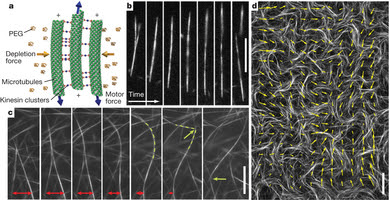New Scientist – Creating drops of the active gel about 30 to 100 micrometres across resulted in something akin to cells that crawled across a microscope slide. “It mimics a little bit what might happen in a living system,” Marchetti says. But the researchers can control how their artificial cells behave. Adjusting the amount of ATP dictates how long the drops stay in motion, while changing the concentration of tubes affects the way they churn.
The key to making the blob mobile was to add nanometre-sized polymers to the solution, which helped draw the tubes into bundles. A motor protein could then span the tight spaces between tubes and cause them to slide past each other in opposite directions. When Dogic and colleagues crammed enough tubes in a small space, they flowed and churned in patterns that resemble a Van Gogh painting in motion.
Active microtubule networks exhibit internally generated flows
Nature – Spontaneous motion in hierarchically assembled active matter
Daniel Chen, a post-doc in Dogic’s lab, imagines that someday the droplets could be controlled well enough to deliver drugsMovie Camera or seek out cancer cells. Because the gel is made of biological material, bodies are less likely to reject it, he says. The gel can also self-heal, so it could help make liquid-crystal displays more robust.
But all of that is a long way off, Dogic cautions. At the moment, the cells tend to turn circles and only cover about 250 micrometres in 33 minutes. The more immediate promise lies in using the way the tubes move to understand swarm behaviour – how patterns form spontaneously in flocks of birds and schools of fish.
“Most of nature is out of equilibrium inherently,” Dogic says. “But it’s hard to get a tunable model system to compare to theory – you can’t do experiments on flocks of birds. This is a model system.
With remarkable precision and reproducibility, cells orchestrate the cooperative action of thousands of nanometre-sized molecular motors to carry out mechanical tasks at much larger length scales, such as cell motility, division and replication. Besides their biological importance, such inherently non-equilibrium processes suggest approaches for developing biomimetic active materials from microscopic components that consume energy to generate continuous motion. Being actively driven, these materials are not constrained by the laws of equilibrium statistical mechanics and can thus exhibit sought-after properties such as autonomous motility, internally generated flows and self-organized beating. Here, starting from extensile microtubule bundles, we hierarchically assemble far-from-equilibrium analogues of conventional polymer gels, liquid crystals and emulsions. At high enough concentration, the microtubules form a percolating active network characterized by internally driven chaotic flows, hydrodynamic instabilities, enhanced transport and fluid mixing. When confined to emulsion droplets, three-dimensional networks spontaneously adsorb onto the droplet surfaces to produce highly active two-dimensional nematic liquid crystals whose streaming flows are controlled by internally generated fractures and self-healing, as well as unbinding and annihilation of oppositely charged disclination defects. The resulting active emulsions exhibit unexpected properties, such as autonomous motility, which are not observed in their passive analogues. Taken together, these observations exemplify how assemblages of animate microscopic objects exhibit collective biomimetic properties that are very different from those found in materials assembled from inanimate building blocks, challenging us to develop a theoretical framework that would allow for a systematic engineering of their far-from-equilibrium material properties.
Penguins of Madagascar – Jiggles
Penguins of Madagascar s01e43 Jiggles
Vezi mai multe video din animatie
If you liked this article, please give it a quick review on ycombinator or StumbleUpon. Thanks

Brian Wang is a Futurist Thought Leader and a popular Science blogger with 1 million readers per month. His blog Nextbigfuture.com is ranked #1 Science News Blog. It covers many disruptive technology and trends including Space, Robotics, Artificial Intelligence, Medicine, Anti-aging Biotechnology, and Nanotechnology.
Known for identifying cutting edge technologies, he is currently a Co-Founder of a startup and fundraiser for high potential early-stage companies. He is the Head of Research for Allocations for deep technology investments and an Angel Investor at Space Angels.
A frequent speaker at corporations, he has been a TEDx speaker, a Singularity University speaker and guest at numerous interviews for radio and podcasts. He is open to public speaking and advising engagements.


